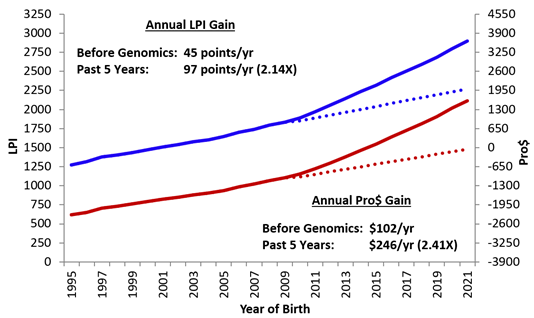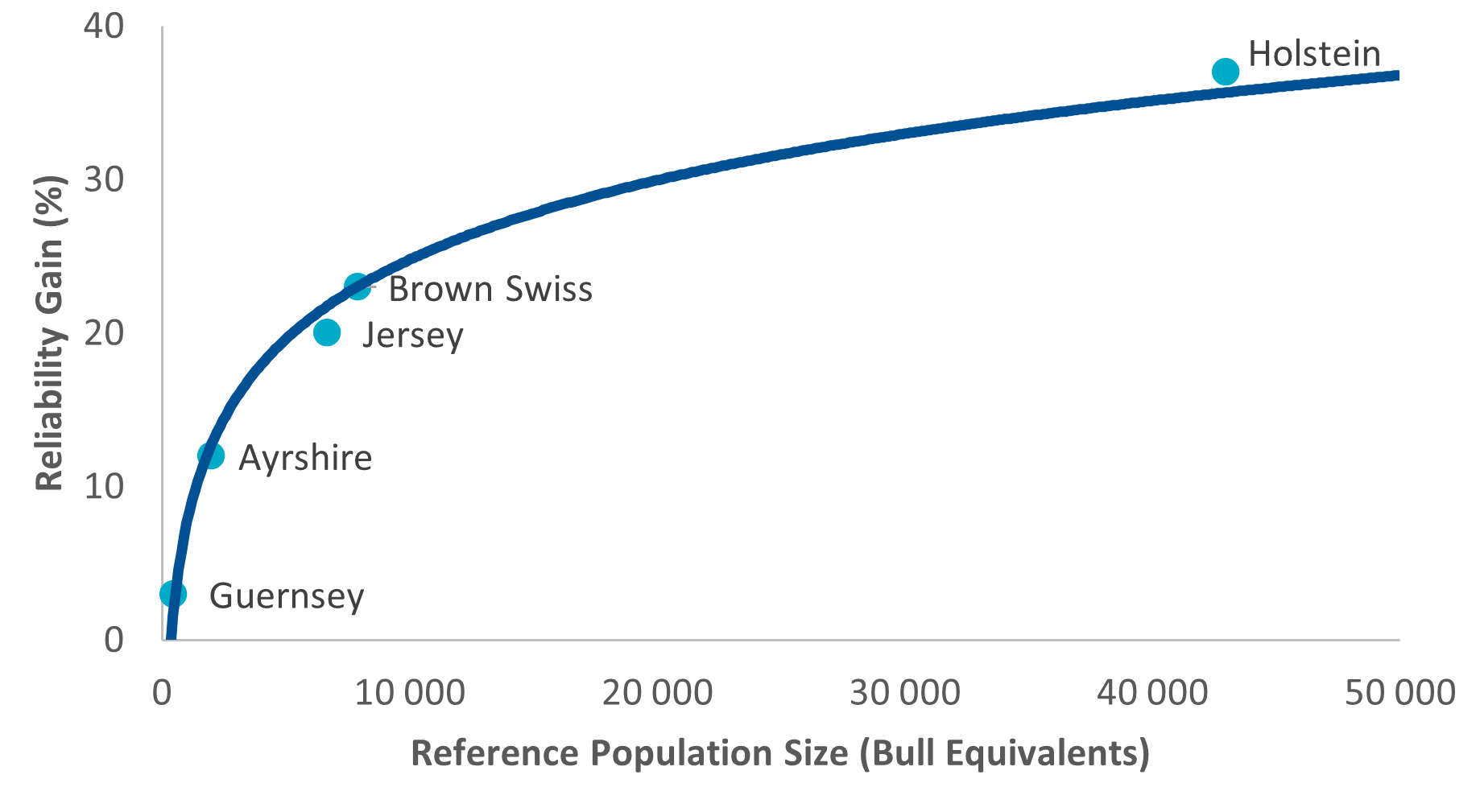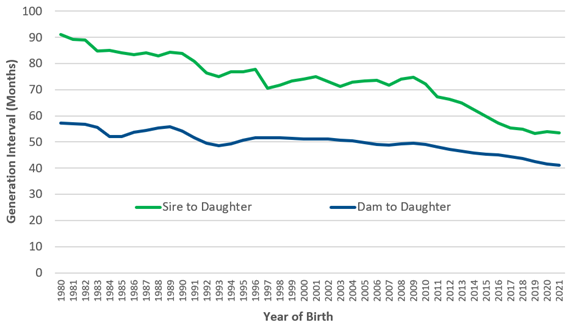There is now no denying that genomics has thoroughly transformed the dairy cattle industry. Since the first Canadian genomic evaluations were published in August 2009, the technology has been embraced by AI organizations and producers.
Earlier this year the database of Lactanet and its international partners surpassed the milestone of 6 million genotypes! While the impact of genomics varies between breeds, genomics has cemented its place as a vital tool in breeding and management decisions. The impact of genomics is seen widely through the industry and its introduction is now a dividing point as we consider trends before and after its arrival.
Accelerated Genetic Progress
One of the most obvious impacts of genomic selection has been the accelerated genetic gains realized. In Holstein, the annual genetic gains in LPI and Pro$ are now more than double what they were in the period prior to genomics as shown in Figure 1.

Most traits under selection have experienced greater rates of gain in the past 5 years compared with the period prior to genomics as presented in Table 1 for the Holstein breed. This includes Daughter Fertility, Milking Temperament, and Lactation Persistency that all had negative genetic trends in Holstein and now have favourable trends. Differences in gains between the two periods also reflect trait inclusion and emphasis in breeding goals or in the case of Dairy Strength, a shift in trait definition. However, the impact of genomics is clear in breeds with genomics and the boost it has provided to the Canadian industry.
| Trait | Before Genomics | Last 5 Years (2016 – 2021) |
| Milk Yield (kg) | 345 | 561 |
| Fat Yield (kg) | 14 | 37 |
| Protein Yield (kg) | 12 | 27 |
| Fat Deviation (%) | 0.01 | 0.13 |
| Protein Deviation (%) | 0.00 | 0.07 |
| Conformation | 3.3 | 3.5 |
| Mammary System | 3.0 | 3.4 |
| Feet & Legs | 1.8 | 2.0 |
| Dairy Strength | 1.9 | 1.8 |
| Rump | 1.4 | 1.0 |
| Herd Life | 0.5 | 2.1 |
| Somatic Cell Score | 0.9 | 2.2 |
| Mastitis Resistance | 0.8 | 1.8 |
| Metabolic Diseases | 0.3 | 1.9 |
| Persistency | -0.2 | 1.5 |
| Daughter Fertility | -0.7 | 1.0 |
| Milking Speed | 0.0 | 0.5 |
| Milking Temperament | -0.3 | 0.9 |
| Daughter Calving Ability | 0.2 | 2.5 |
Increased Accuracy
The main factor behind the strong genetic progress seen with genomics is the increased accuracy it brings to genetic evaluations, especially for young animals. The gain in reliability with genomics is related to the size of the reference population used as the basis for genomic predictions (Figure 2). The Holstein reference population is comprised of approximately 43,000 genotyped progeny proven sires, which translates to the average LPI reliability increasing 37 percentage points from 41% to 78% in young animals. For perspective, prior to the addition of genomics, the average LPI reliability of a first crop progeny proven Holstein sire is only marginally higher at 83%. The opportunity exists for smaller population breeds in Canada to see higher reliability gains by continuing to genomically test their animals to grow the reference population.

The Rise of Genomic Young Bulls
The increased accuracy with genomic evaluations has also affected selection intensity and generation interval, which contribute to driving the annual rate of genetic gains upward. Genomic Parent Averages (GPA) have essentially replaced Parent Averages (PA) in males with reliabilities that now, on average, exceed 70% in Holstein. The best prospective young bulls can be selected at a very young age, resulting in only the most elite being purchase for AI. The demand for genomic young bulls has increased, ultimately doing away with traditional young sire incentive programs. Although progeny testing to develop proven sires has not disappeared, it is no longer the focus of dairy cattle improvement programs. In fact, roughly two-thirds of semen used in recent years has been from genomic young bulls and the remainder is semen from progeny proven sires. The increased accuracy of genetic information for young animals has therefore had a significant impact on reducing the generation interval between parent and progeny. As shown in Figure 3 for the Holstein breed, the average age of the sires of heifers born in 2021 is now 20 months younger with genomics compared to before it was introduced. Even on the dam side, they are now an average of 8.5 months younger than before the genomics era. The current fast-paced environment where younger animals are being used to produce the next generation of AI bulls and replacement heifers stems from the faster rates of genetic progress with relatively little loss of accuracy in terms of selection and mating decisions.

The Emergence of Novel Traits
More broad and balanced selection goals have emerged in dairy cattle breeding in recent decades with more emphasis being placed on health, reproduction, and efficient and sustainable production. Although this evolution was not born from genomics, it is genomics that permits selection and allows for more substantial genetic progress for many of the novel traits that may have low heritability or be difficult or expensive to measure. Low heritability is not a barrier to selection with genomics and genetic progress in lower heritability traits, such as Daughter Fertility, are now on par with more heritable traits. Many novel traits important for genetic selection in the dairy industry have fewer animals with records accumulated in comparison to established traits such as production, which have benefited from large national data collection systems and were very successfully selected for with traditional methods. Genomics has now allowed for selection for traits like Feed Efficiency, which would not have been possible previously, and the list of genetic evaluations for valuable traits will only continue to expand delivering tools for a profitable and sustainable industry.
Additional Benefits
In addition to genomic evaluations, genotyping provides other important benefits to the industry. Genotyping an animal can confirm the recorded parentage for any parent also genotyped. With all AI bulls now being genotyped, essentially all sires can be confirmed or in the event of a recording error, the correct sire can be identified. This aids in maintaining herdbook integrity and further ensures the genetic information used for herd management decisions is as accurate as possible.
Another crucial advantage genomic testing brings is the ability to discover and manage genetic recessives and haplotypes. Examples include the various haplotypes affecting fertility in each breed, Cholesterol Deficiency (CD) in Holsteins, the Curly Calf Syndrome (AM) in Ayrshires and Jersey Neuropathy with Splayed Forelimbs (JNS) in Jerseys. The management of such known genetic abnormalities is imperative within each breed and at the herd level. Genomic testing of females can help identify carriers of these undesirable genetic abnormalities so that matings of two carriers can be avoided.
Summary
Almost thirteen years have now passed since the introduction of genomic evaluations in Canada, and it has left its mark throughout the industry. Most strikingly, the rate of genetic progress for essentially all traits of importance has increased due to genomics and the increased accuracy it provides to genetic evaluations, especially for young animals. Genomics continues to alter the landscape of genetic evaluations being offered and traits where genetic progress can be achieved. The impact genomics has already had on the Canadian dairy cattle industry is huge and as advances in this tool continue, many future opportunities surely await.
Source: Lactanet











